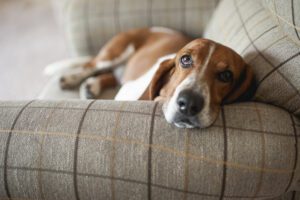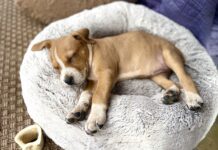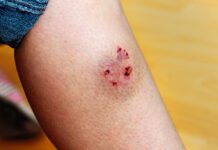You have realized that your lifestyle is best suited for a low-key canine companion. So which of the breed-types are known to be low-energy dogs? These calm canines range from small to giant, so you have your choice of size. If you’re also looking for a dog who is easy to care for take note: Some low-energy breeds also have extra grooming or medical needs. Here are some of the better-known options:
Low-Energy Large Breeds
Many giant breeds are known for their calm demeanor – but also for short life spans (6 to 10 years on average). These big guys may be particularly prone to several health conditions, including hip dysplasia, dilated cardiomyopathy, and bloat/torsion – and some of them are fairly well known for their propensity to drool! But the dogs of these breeds tend to be very mellow, easy-going temperaments:
- Bernard – Usually lovable, gentle goofballs who enjoy cuddling.
- Newfoundland – Typically gentle and sweet-tempered.
- Great Pyrenees – Generally confident, strong-willed but gentle dogs.
- Bernese Mountain Dog – Often called “gentle giants,” intelligent and loyal.
- Irish Wolfhound – Known as particularly patient, thoughtful, and dignified dogs.
- Great Dane – Described as devoted, gentle, and reserved.
Low-Energy Medium-Sized Breeds
Many mid-sized dogs are high energy (think herding, sporting, and working breeds). Here are some that tend toward calm. Some of the health issues common to these breeds include hypothyroidism, hip dysplasia, canine atopic dermatitis (particularly in breeds with skin folds, like the Shar Pei), breathing issues (in flat-faced breeds such as Bulldogs), dilated cardiomyopathy, and back problems (particularly in short-legged, long-backed dogs such as Bassett Hounds).
- Chow Chow – These reserved and dignified dogs can be cautious around strangers.
- Shar-Pei – These independent dogs can also be suspicious of strangers.
- English Bulldog – Described as kind, friendly, and dignified.
- Bassett Hound – Sweet-tempered, affectionate, and gentle.
- Clumber Spaniel – Tend to be dignified, loyal and calm.
Low-Energy Small Dog Breeds
Appreciate the value of a low-energy lap dog! Some do have very significant health issues, especially breathing problems with the currently very popular brachycephalic (short-nosed) breeds (such as the French Bulldog, Pug, Boston Terrier, Pekingese) and the adorable but afflicted Cavalier King Charles Spaniel (skull too small for the brain, breathing problems, eye problems, heart problems). If buying a puppy, look for breeders who can provide health records for the pup’s parents. Also, note that some of these breeds have high grooming needs.
- Bichon Frise – Generally friendly, intelligent, and cheerful.
- Maltese –Reportedly smart, playful, and sweet with a mild demeanor.
- Havanese – Described as friendly, affectionate, playful, and intelligent.
- Cavalier King Charles Spaniel – Known to be affectionate, playful, gentle, and sociable.
- Pug – Tend to be affectionate, charming, gentle, and playful.
- French Bulldog – The current darling of the dog show ring, known as bright, easygoing, and affectionate.
- Boston Terrier – Friendly, affectionate, and gentle.
- Pekingese – Loyal and loving, can be aloof and protective with strangers.
Regardless of which breeds have a reputation for being low-energy dogs, remember that each dog is an individual. If you make the mistake of snatching up the first Bassett Hound you come across (or purchasing one sight-unseen after an internet search) you could end up with a wild-and-crazy non-stop energizer doggie. Be sure to carefully evaluate the dog in front of you to make sure she’ll be the right fit for your low-key world. Don’t forget that all dogs need enrichment and mental stimulation, even if they don’t need lots of physical exercise, and you’ll need to watch their diet so you don’t end up with an obese low-energy dog.







You left out greyhounds, the sweetest, laziest breed ever!